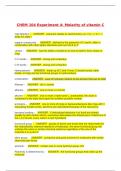Chem 104 experiment - Study guides, Class notes & Summaries
Looking for the best study guides, study notes and summaries about Chem 104 experiment? On this page you'll find 43 study documents about Chem 104 experiment.
Page 2 out of 43 results
Sort by
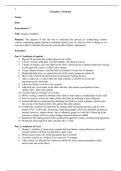
-
CHEM 104 Experiment 7, Organic synthesis Summer 2023 portage learning
- Other • 4 pages • 2023
-
Available in package deal
-
- $14.49
- + learn more
Experiment #: 7 Title: Organic Synthesis Purpose: The purpose of this lab was to determine the process of synthesizing various carboncontaining organic products including aspirin, urea, & salicylic acid. In doing so, we were also able to calculate the percent yield in each of these experiments. Procedure: Part 1: Synthesis of aspirin 1. Placed 2.0 g of salicylic acid & placed it in a flask 2. 5.0 mL of acetic anhydride was then added to the flask & mixed 3. 5 drops of sulfuric acid was a...
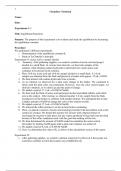
-
CHEM 104 Experiment 2 Equilibrium Reactions Summer 2023 portage learning
- Other • 4 pages • 2023
-
Available in package deal
-
- $14.49
- + learn more
Experiment #: 2 Title: Equilibrium Reactions Purpose: The purpose of this experiment is to evaluate and study the equilibrium by measuring the equilibrium constant. Procedure: We performed 2 different experiments: o Determination of the equilibrium constant Kc o Study of LeChatelier’s principle Experiment #1: acetic acid vs. propyl alcohol 1. Summary: After gathering supplies, we created a solution of acetic acid and propyl alcohol in a small flask. At various time intervals, we then...
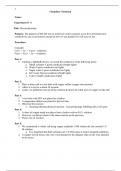
-
CHEM 104 Experiment 6: Electrochemistry Summer 2023 Portage learning
- Other • 3 pages • 2023
-
Available in package deal
-
- $13.49
- + learn more
Experiment #: 6 Title: Electrochemistry Purpose: The purpose of this lab was to study how redox reactions occur & to determine how conductivity can occur between metals & how we can predict if it will react or not. Procedure: Consider: Cu2+ + 2e- -> Cu(s) = reduction Fe(s) -> Fe2+ + 2e- = oxidation Part 1: 1. Utilizing a lightbulb device, we tested the conductive of the following items: a. Metal cylinder good conductor (bright light) b. Water poor conductor (no light) c...

-
CHEM 104 Experiment 5: Buffers - Portage Learning
- Exam (elaborations) • 4 pages • 2023
- Available in package deal
-
- $13.49
- + learn more
CHEM 104 Experiment 5: Buffers - Portage Learning Purpose: The purpose of this lab is to determine how buffers affect the pH of a solution in order to observe how a buffer is resistant to pH changes. Additionally, we determined how enzymes activity is affected by pH. Procedure: Part 1: Determine pH of sodium acetate in water & buffer 1. 2 pH electrodes are place in 2 separate beakers, one filled with tap water & one is filled with a pH 7 buffer (both have an approximate pH of 7) 2. A scoop of s...
CHEM 104 Experiment 4: Molarity of vitamin C
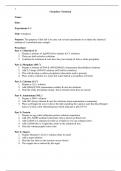
-
CHEM 104 Experiment 8 : Urinalysis summer 2023 portage learning (Chemistry notebook)
- Other • 3 pages • 2023
-
Available in package deal
-
- $13.49
- + learn more
Experiment #: 8 Title: Urinalysis Purpose: The purpose of this lab is to carry out several experiments to evaluate the chemical makeup of a simulated urine sample. Procedure: Part 1: Chloride (Cl- ) 1. Prepare a mixture of AgNO3(silver nitrate) & Cl- solutions 2. These are both colorless solutions 3. Combine the solutions & note how they turn cloudy & form a white precipitate Part 2: Phosphate (PO3 -3) 1. Prepare a mixture of PO4 & (NH4)2MoO3 (Ammonium dimolybdate) solutions 2. Add ...
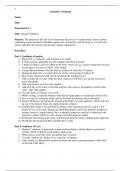
-
CHEM 104 Experiment 7 Organic Synthesis - Portage Learning
- Exam (elaborations) • 4 pages • 2023
- Available in package deal
-
- $14.49
- + learn more
CHEM 104 Experiment 7 Organic Synthesis - Portage Learning Purpose: The purpose of this lab was to determine the process of synthesizing various carboncontaining organic products including aspirin, urea, & salicylic acid. In doing so, we were also able to calculate the percent yield in each of these experiments. Procedure: Part 1: Synthesis of aspirin 1. Placed 2.0 g of salicylic acid & placed it in a flask 2. 5.0 mL of acetic anhydride was then added to the flask & mixed 3. 5 drops of sulfuric...
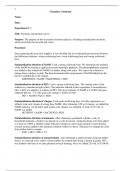
-
CHEM 104 Experiment 3 Titrations and Titration Curves - Portage Learning
- Exam (elaborations) • 4 pages • 2023
- Available in package deal
-
- $14.49
- + learn more
CHEM 104 Experiment 3 Titrations and Titration Curves - Portage Learning Purpose: The purpose of this to perform titration analyses, including neutralization titrations, which occur between an acid and a base. Procedure: After gathering the necessary supplies, it was decided that we would perform reactions between the following solutions: strong acid/strong base, weak acid/strong base and strong acid/weak base. Standardization titration of NaOH: Used a strong acid/weak base. We determine the mo...
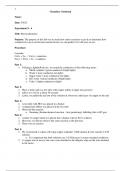
-
CHEM 104 Experiment 6: Electrochemistry - Portage Learning
- Exam (elaborations) • 3 pages • 2023
- Available in package deal
-
- $13.49
- + learn more
CHEM 104 Experiment 6: Electrochemistry - Portage Learning Purpose: The purpose of this lab was to study how redox reactions occur & to determine how conductivity can occur between metals & how we can predict if it will react or not. Procedure: Consider: Cu2+ + 2e- -> Cu(s) = reduction Fe(s) -> Fe2+ + 2e- = oxidation Part 1: 1. Utilizing a lightbulb device, we tested the conductive of the following items: a. Metal cylinder good conductor (bright light) b. Water poor conductor (no ...
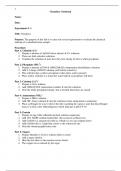
-
CHEM 104 Experiment 8: Urinalysis - Portage Learning
- Exam (elaborations) • 3 pages • 2023
- Available in package deal
-
- $13.49
- + learn more
CHEM 104 Experiment 8: Urinalysis - Portage Learning Purpose: The purpose of this lab is to carry out several experiments to evaluate the chemical makeup of a simulated urine sample. Procedure: Part 1: Chloride (Cl- ) 1. Prepare a mixture of AgNO3(silver nitrate) & Cl- solutions 2. These are both colorless solutions 3. Combine the solutions & note how they turn cloudy & form a white precipitate Part 2: Phosphate (PO3 -3) 1. Prepare a mixture of PO4 & (NH4)2MoO3 (Ammonium dimolybdate) solutions ...

Do you wonder why so many students wear nice clothes, have money to spare and enjoy tons of free time? Well, they sell on Stuvia! Imagine your study notes being downloaded a dozen times for $15 each. Every. Single. Day. Discover all about earning on Stuvia

